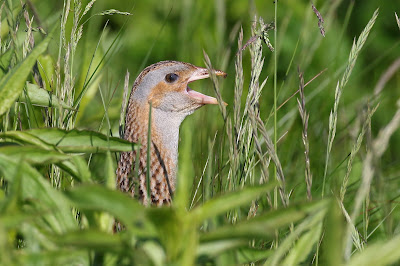The Corncrake
Crex crex calls its scientific name through the night from the gardens, iris beds and haymeadows of North Uist, where I spent some time at the start of the half-term holidays. We had heard several and seen one scuttling through low vegetation early on our first morning on the island, and after spending the rest of the day cruising around the island chain looking for breeding waders, scanning for eagles and searching for Twite, we headed back to the Bayhead area for another look at the Black-billed Cuckoo. We couldn't improve on our views of the previous evening, but as we leant on a wall waiting for it to show a rasping call from the other side of the wall gave away the presence of a male Corncrake declaring his intentions.
We could only just see over the neck high wall so were able to listen and take a few photos without perturbing the bird, which continued to call, despite the house owner mowing part of the lawn it was calling from. Every now and again a comedy head would appear through the vegetation and duck down quickly again, reminding me of
the scene in Jurassic Park where the velociraptors do the same when hunting the appropriately named Bob Peck! The Corncrake moved up and down the garden and at one point came close enough for us to see the nictitating membrane over the eye and saliva on the mandibles, presumably required to lubricate the throat for that distinctive call, which is said to be given up to 20,000 times per night. The owner of the garden complained about the nocturnal racket but we agreed we would be quite happy to be
crexed to sleep by this once commonplace but now very rare breeding bird.
The decline of the Corncrake in Britain is linked to the mechanisation of hay mowing, but a more recent recovery in the breeding population has been made possible as more grassland has been managed for corncrakes in Scotland via EU agri-environment schemes.




No comments:
Post a Comment